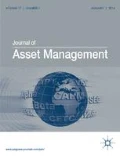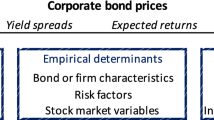Abstract
Doubts are rising whether bond indices, in the way they are constructed, are effective in their role of representing the markets they are designed for. Since index constituents are defined on market shares – the larger the debt obligation, the larger the share in the index – it may be that certain risks related to a high level of indebtedness are being accentuated which are not necessarily representative for the market as a whole. Undue debt levels would in theory not arise in an information-efficient market, however, if prices are distorted and do not convey information efficiently, it makes sense to compensate for that and integrate elementary information on the debt issuers into the index construction process. We test how that works out on corporate bonds. We build an index that is based on firm accounting data rather than debt size, and give evidence that it serves as a market proxy.




Similar content being viewed by others
Notes
Calculations available from the authors upon request.
We use an independent bond market index to avoid too high correlation levels between the DEF factor and the CW benchmark.
References
Al-Khazali, O.M. and Zoubi, T.A. (2011) Empirical testing of different alternative proxy measures for firm size. Journal of Applied Business Research 21 (3): 79–90.
AlMahdhi, S. (2015) Smart beta portfolio optimization. Journal of Mathematical Finance 5 (2): 202.
Altman, E.I. (1968) Financial ratios, discriminant analysis, and the prediction of corporate bankruptcy. Journal of Finance 23 (4): 589–609.
Amenc, N., Goltz, F. and Lodh, A. (2012) Choose your betas: Benchmarking alternative equity index strategies. Journal of Portfolio Management 39 (1): 88–111.
Amenc, N., Goltz, F. and Martellini, L. (2013) Smart Beta 2.0. EDHEC-Risk Position Paper.
Arnott, R., Hsu, J., Li, F. and Shepherd, S.D. (2010) Valuation-indifferent weighting for bonds. Journal of Portfolio Management 36 (3): 117–130.
Arnott, R.D., Hsu, J.C. and Moore, P. (2005) Fundamental indexation. Financial Analysts Journal 61 (2): 83–99.
Arnott, R.D. and Markowitz, H.M. (2008) Fundamentally flawed indexing: Comments. Financial Analysts Journal 64 (2): 12–14.
Asness, C. (2006) The value of fundamental indexation. Institutional Investor 40 (10): 94–99.
Bakshi, G., Madan, D. and Zhang, F.X. (2006) Investigating the role of systematic and firm-specific factors in default risk: Lessons from empirically evaluating credit risk models. Journal of Business 79 (4): 1955–1987.
Balchunas, E. (2014) Smart beta: The investing buzzword that won’t – And needn’t – Die. Bloomberg News 27 August.
Basu, A.K. and Forbes, B. (2013) Does fundamental indexation lead to better risk-adjusted returns? New evidence from Australian securities exchange. Accounting & Finance 53 (3): 1–30.
Beaver, W. (1966) Financial ratios as predictors of failure. Journal of Accounting Research 4, 91–101.
Black, F. and Scholes, M. (1973) The pricing of options and corporate liabilities. Journal of Political Economy: 637–654.
Blitz, D. and Swinkels, L. (2008) Fundamental indexation: An active value strategy in disguise. Journal of Asset Management 9 (4): 264–269.
Campbell, J.Y., Hilscher, J. and Szilagyi, J. (2011) Predicting financial distress and the performance of distressed stocks. Journal of Investment Management 9 (2): 14–34.
Chen, C., Chen, R. and Bassett, G.W. (2007) Fundamental indexation via smoothed cap weights. Journal of Banking and Finance 31 (11): 3486–3502.
Chow, T.M., Hsu, J., Kalesnik, V. and Little, B. (2011) A Survey of Alternative Equity Index Strategies. Financial Analysts Journal 67 (5): 37–57.
Collin-Dufresne, P., Goldstein, R.S. and Martin, J.S. (2001) The determinants of credit spread changes. Journal of Finance 56 (6): 2177–2208.
Das, S., Kalimipalli, M. and Nayak, S. (2014) Did CDS trading improve the market for corporate bonds? Journal of Financial Economics 111 (2): 495–525.
de Jong, M. and Wu, H. (2014) Fundamental indexation for bond markets. Journal of Risk Finance 15 (3): 264–274.
DeMiguel, V., Garlappi, L. and Uppal, R. (2009) Optimal versus naive diversification: How inefficient is the 1/N portfolio strategy? Review of Financial Studies 22 (5): 1915–1953.
Dijkstra, T.K. (2015) On Perold’s ‘fundamentally flawed indexing’, http://www.researchgate.net/publication/238240589, accessed 20 October 2015.
Downing, C., Underwood, S. and Xing, Y. (2009) The relative informational efficiency of stocks and bonds: An intraday analysis. Journal of Financial and Quantitative Analysis 44 (5): 1081–1102.
Estrada, J. (2008) Fundamental indexation and international diversification. Journal of Portfolio Management 34 (3): 93–109.
Falcon, L.T. (2007) Logit Models to Assess Credit Risk. Credit Risk Assessment Revisited: Methodological Issues and Practical Implications, European Committee of Central Balance Sheet data Offices Working Group on Risk Assessment, pp. 95–118.
Fama, E. (1970) Efficient capital markets: A review of theory and empirical work. Journal of Finance 25 (2): 383–417.
Fama, E.F. and French, K.R. (1993) Common risk factors in the returns on stocks and bonds. Journal of Financial Economics 33 (1): 3–56.
Gebhardt, W.R., Hvidkjaer, S. and Swaminathan, B. (2005) The cross-section of expected corporate bond returns: Betas or characteristics?. Journal of Financial Economics 75 (1): 85–114.
Hemminki, J. and Puttonen, V. (2008) Fundamental indexation in Europe. Journal of Asset Management 8 (6): 401–405.
Herfindahl, O. (1950) Concentration in the US steel industry, unpublished doctoral dissertation, Columbia University, New York.
Houweling, P., Mentink, A. and Vorst, T. (2005) Comparing possible proxies of corporate bond liquidity. Journal of Banking and Finance 29 (6): 1331–1358.
Houwer, R. and Plantinga, A. (2009) Fundamental Indexing: An Analysis of the Returns, Risks and Costs of Applying the Strategy. SSRN.
Hsu, J. (2006) Cap-weighted portfolios are sub-optimal portfolios. Journal of Investment Management 4 (3): 44–53.
Hsu, J.C. and Campollo, C. (2006) An examination of fundamental indexation. New Frontiers in Index Investing. Journal of Indexes 58, 32–37.
Hsu, J.C., Kalesnik, V. and Xie, S. (2011) What makes fundamental index methodology work? Working Paper, Newport Beach, CA: Research Affiliates.
Huang, J. and Huang, M. (2003) How much of the corporate-treasury yield spread is due to credit risk? Review of Asset Pricing Studies 2 (2): 153–202.
Jacobs, B.I. and Levy, K.N. (2014) Smart beta versus smart alpha. The Journal of Portfolio Management 40 (4): 4–7.
Jacobs, B.I. and Levy, K.N. (2015) Smart beta: Too good to be true? The Journal of Financial Perspectives 3 (2): 1–9.
Kaplan, P. and Arnott, R. (2008) in Kaplan, P. (2012) Frontiers of Modern Asset Allocation. Chapter 4, Wiley Online Library, http://www.etf.com/publications/journalofindices/joi-articles/5139-the-fundamental-debate.html?nopaging=1.
Kwan, S.H. (1996) Firm specific information and the correlation between individual stocks and bonds. Journal of Financial Economics 40 (1): 63–80.
Malkiel, B.G. (2014) Is smart beta really smart? The Journal of Portfolio Management 40 (5): 127.
Merton, R.C. (1974) On the pricing of corporate debt: The risk structure of interest rates. Journal of Finance 29 (2): 449–470.
Modigliani, F. and Miller, M. (1958) The cost of capital, corporation finance and the theory of investment. The American Economic Review 48 (3): 261–297.
Moles, P., Parrino, R. and Kidwell, D. (2011) Fundamentals of Corporate Finance. Hoboken, NJ: Wiley.
Ohlson, J.A. (1980) Financial ratios and the probabilistic prediction of bankruptcy. Journal of Accounting Research 18: 109–131.
Perold, A.F. (2007) Fundamentally flawed indexing. Financial Analysts Journal 63 (6): 31–37.
Perold, A.F. (2008) Fundamentally flawed indexation: Author response. Financial Analysts Journal 64 (2): 14–17.
Roncalli, T. (2013) Introduction to Risk Parity and Budgeting. Chapman & Hall, CRC Financial Mathematics Series.
Sharpe, W.F. (1964) Capital asset prices: A theory of market equilibrium under conditions of risk. Journal of Finance 19 (3): 425–442.
Shepherd, S. (2015) Smart Beta For Corporate Bonds. Research Affiliates White Paper (February).
Siegel, L.B. (2003) Benchmarks and Investment Management. Charlottesville, VA: CFA Institute.
Staal, A., Corsi, M., Shores, S. and Woida, C. (2015) A factor approach to smart beta development in fixed income. The Journal of Index Investing 6 (1): 98–110.
Tamura, H. and Shimizu, Y. (2005) Fundamental indices: Do they outperform market-cap weighted indices on a global basis? Security Analysts Journal 43 (10): 32–46.
Treynor, J. (2008) Fundamentally flawed indices: Comments. Financial Analysts Journal 64 (2): 14–14.
Walkshusl, C. and Lobe, S. (2010) Fundamental indexing around the world. Review of Financial Economics 19 (3): 117–127.
Whalen, G. and Thomson, J.B. (1988) Using financial data to identify changes in bank condition. Economic Review 24. Federal Reserve Bank of Cleveland, 17–26.
Acknowledgements
The authors would like to thank Valérie Mignon, Frédéric Lepetit, Valentine Ainouz and Bruce Phelps for their valuable suggestions.
Author information
Authors and Affiliations
Corresponding author
Additional information
The views expressed in this article are those of the authors and do not necessarily reflect those of Amundi.
APPENDIX
Rights and permissions
About this article
Cite this article
de Jong, M., Stagnol, L. A fundamental bond index including solvency criteria. J Asset Manag 17, 280–294 (2016). https://doi.org/10.1057/jam.2016.15
Received:
Revised:
Published:
Issue Date:
DOI: https://doi.org/10.1057/jam.2016.15




